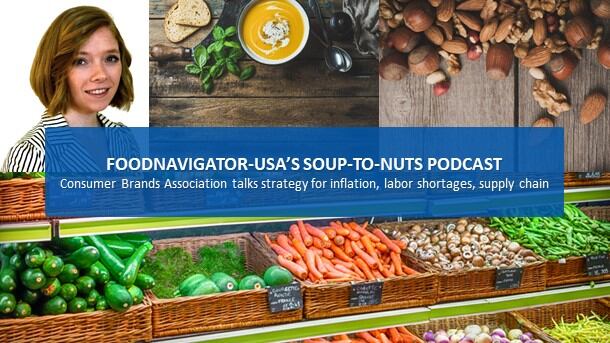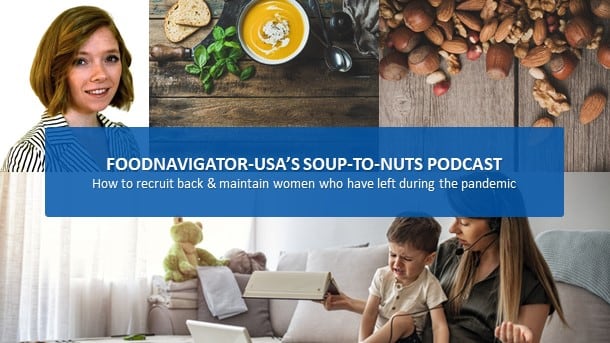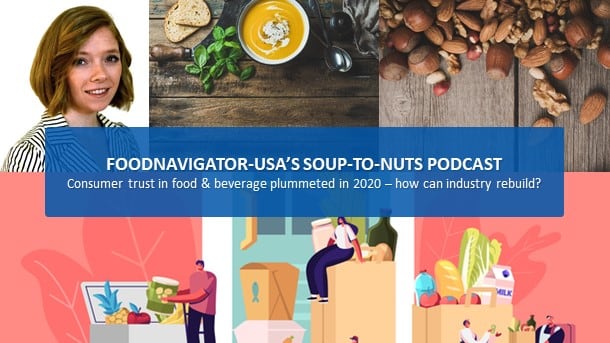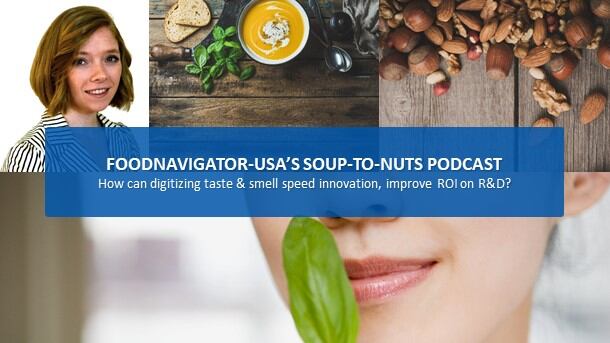Looking back on 2020, the Consumer Brands Association notes that the CPG industry has much to be proud of, including quickly adjusting supply chains and hiring employees to meet an unrelenting consumer demand that drove up sales 21% in March and 9.4% to $131 billion for the full year over 2019. And while the industry outperformed the broader economy in many ways last year, it also continues to grapple with unique restrictions that if left unchecked could drag down year-over-year results.
In this episode of FoodNavigator-USA’s Soup-To-Nuts Podcast, Consumer Brands Association President and CEO Geoff Freeman acknowledges the industry’s fortitude and creativity in tackling many of the unexpected challenges of 2020, and shares what it will take to do the same for lingering and new but related issues, including labor constraints, rising inflation and ongoing supply chain limitations.
“2020 was a test unlike any the industry has ever seen before, and hopefully unlike one we will see again. And I think it was a test on a variety of levels,” Freeman said, noting the amount of product consumers needed, where they needed them (at home versus work or restaurants) and for a sustained period all challenged CPG players.
But, he added, “the industry was able to provide the American consumers what they were looking for.”
[Editor's Note: Never miss another episode of FoodNavigator-USA's Soup-To-Nuts Podcast -- subscribe today.]
“The workforce in this industry rose to the occasion and did incredible things”
One way the CPG industry balanced increased demand with limited resources was to rationalize production by prioritizing essential and best-selling products – temporarily, or in some cases permanently, pausing production of others.
The CPG industry also leaned heavily on its employees and bringing on new hires at a time when other industries were furloughing and letting go of staff. In many cases, Freeman notes employee contributions and sacrifices were recognized with bonuses and pay increases, making the CPG industry an attractive segment.
“The thing that enabled the industry to meet demand was the workforce. The workforce in this industry rose to the occasion and did incredible things. We saw an increase in our regional facilities that would run five days a week were now running six and seven days a week. Facilities that would run two shifts, usually were not running three shifts. Facilities that would be closed on various holidays now were working right through those holidays,” Freeman said.
“And that was a big achievement,” that was recognized in wage increases and bonuses so that the CPG industry paid on average 3.5% more than the previous year – an increased made more notable by the 1% drop in wages in the overall economy during the period, he added.
The higher wages made the CPG industry more attractive for potential employees, but Freeman cautions the ongoing elevated consumer demand for products is creating unsustainable workforce pressure which may require government intervention to alleviate.
As a result, the CPG industry in a variety of areas is struggling to find employees to meet demand for manufacturing, transportation and specialty skills.
Historically in tight labor markets companies hoping to hire have sweetened offers with added benefits, perks and higher wages or salaries. But with many companies having increased pay bands recently already and rising inflation limiting the potential for additional wage and salary increases, Freeman says industry players will have to become creative in how they attract and retain qualified candidates. Those decisions also will need to be weighed against other cost management strategies.
There's no doubt right now that we're in inflationary period we are in a period of skyrocketing costs, and it's happening across all elements of the CPG industry from the basic commodities the ingredients to the materials that these products are packaged in to the transportation aspects of these products to the workforce. Every single one of these is seeing dramatic increases in costs, so it's hard to I think for big companies, to look at the workforce in a vacuum and say okay we're going to compete by paying more,” Freeman said, adding that in general the industry does pay will and instead will have to look for more creative ways to continue to attract qualified candidates.
Managing restrictive costs & supply chains
With limited abilities to pass price through to consumers, many CPG players are pursuing other cost efficiency strategies, including within their supply chains. However, they must tread carefully because many of the supply chain vulnerabilities exposed by the pandemic persist despite concerted efforts to reinforce weaknesses.
With this in mind, Freeman lauded the Biden Administration’s American Jobs Plan proposed at the end of March, which includes measures to reinforce supply chains and potentially help alleviate current labor shortages. Specifically, the proposal suggests investing $50 billion to create a new office at the Department of Commerce “dedicated to monitoring domestic industrial capacity and funding investments to support production of critical goods,” and seeks to bolster community college partnerships to provide job training for in-demand skills.
“We were thrilled to see in the infrastructure package, the President put forward, substantial funding for an office of supply chain within the Department of Commerce, that office does not exist today. There is no one at a national level, that has their finger on the pulse of the supply chain, both coming into the United States and within the United States, how product is getting to market, where the holdups are, what can be done to address some of these things, we need to have some of that perspective at a higher level within government and we're thrilled to see the investment in that area because this is an area that needs more attention than it's gotten in the past,” Freeman said. He added that the supply chain also is more than road and rails – it also includes the ports where “we’ve got huge issues.”
Some of the strains on the supply chain are rooted in insufficient staff, which Freeman also lauded the plan for addressing through funding for community colleges and technical skill and trade training.
Easing inflation and escalating costs
The Consumer Brands Association also is urging the government to take additional steps to help alleviate challenges related to rising costs, labor requirements and consumer demands – all of which the trade group notes in a letter sent to the National Economic Council May 13 are surging to levels not seen since March 2020.
“We understand that there are so many factors here that are driving this that government policy isn’t going to solve all aspects of the problem, but there are things that can be incremental,” Freeman said.
For example, he noted: “some of that is solving the shipping container shortage that we’re seeing within our ports,” and some is safely adjusting how much weight trucks can move to maximize space and transportation.
CBA also asks the National Economic Council to ensure efficient clearances, inspections, safety checks and other required actions to avoid supply chain delays. In addition it asks the government to encourage a return to work through education programs and increased flexibility to unemployment and assistance programs. CBA also asks for updated workplace guidance to reflect vaccination status, and that the government accelerate Federal Maritime Commission efforts to address ocean carrier consolidation and declining maritime shipping performance and port delays.
A national approach to regulations creates a more even playing field
CBA also is advocating for stronger federal government oversight of key regulations that currently are being managed at the state level – creating an uneven playing field that hinders reputable brands’ ability to meet consumer demand.
“One of the biggest disruptions for our business – a business of scale – is we have California going in one direction, New York going in a different direction, a third state going a completely different direction. We are destroying the power of scale,” Freeman said.
By creating consistent regulations nationwide, companies can more efficiently deliver to meet consumer demand.
Ultimately, Freeman says a collaborative approach between industry and government is essential for rebuilding after the pandemic and ensuring the hard lessons learned during the last 15 months are applied to support smart growth for the CPG industry and broader American economy and population.
“We have we have made it through to the other side of a pandemic here and there are a lot of lessons learned, and those lessons are about the importance of partnership, those lessons are about the power of scale, those lessons are about this newfound trade, that is, you know, kitchen table discussion in supply chain, that the details matter, and how we provide for the American people matters. And we need partners within government, who will help us continue to do that for many, many years to come,” Freeman said.
He added, “We've been very pleased in our initial interactions with the Biden administration, the steps they've taken on supply chain, the interest they've shown in some of the priorities that we've presented them. So, we're hopeful for a strong and lasting partnership here with the Biden administration.”




